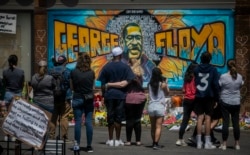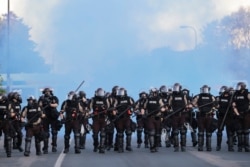Hundreds of cities across the U.S. have imposed curfews Tuesday as a way to try to tamp down protests continued protests against the death of an African American man while in the custody of a white policeman.
An official finding of homicide has been announced in the death of George Floyd, who died last week after a white officer, Derek Chauvin, kneeled on his neck for more than 8 minutes while he was pinned to the ground in handcuffs and pleading that he could not breathe.
The incident, captured on video, has sparked demonstrations in dozens of American cities, the most widespread outbreak of civil unrest in decades.
After protests and violent outbreaks near the White House on Sunday, President Donald Trump threatened in a Rose Garden address Monday to deploy U.S. military troops to cities to stop any further violent protests.
Federal authorities fired rubber bullets and tear gas to disperse peaceful protesters outside the White House during Trump’s remarks, clearing the way for him to walk to a nearby church and pose for photographs with a Bible in hand. That drew condemnation from House Speaker Nancy Pelosi and Senate Democratic leader Charles Schumer.
Video and photos showed military helicopters in Washington hovering below building height, not far above protestors, snapping branches off trees and stirring up debris.
Protesters, who are also demanding an end to generations of racism, took to the streets in other U.S. cities as well, including the Midwestern city of St. Louis, where four police officers were shot early Tuesday.
Peaceful daytime protests turned violent after nightfall and the four officers were shot shortly after midnight. Officials said their injuries are not considered life-threatening.
Despite an extraordinary 11 p.m. curfew in New York, the largest city in the U.S., groups of people smashed windows and looted stores including Macy’s flagship store in Manhattan. Police said an officer was hospitalized in critical condition after being struck by a hit-and-run driver in the Bronx.
In the northwestern city of Seattle, protesters clashed with police Monday night. NBC News reports that correspondent Jo Ling Kent was struck by a flashbang projectile fired by police but was not injured. There have also been reports in many cities of police injuring journalists who were covering the protests.
A 6 p.m. curfew in the northeastern city of Philadelphia did not stop protestors from marching to City Hall on Monday. Larger crowds shut down traffic earlier in other parts of the city as law enforcers used tear gas and pepper spray to disperse them.
In the Midwestern city of Minneapolis, peaceful demonstrators continued to gather at the site of Floyd’s deadly encounter with police. Police arrived at the scene after the 10 p.m. curfew. Police also moved in on peaceful protestors who spent the evening at the Minnesota State Capitol.
Meanwhile, Minnesota officials have said George Floyd suffered from a loss of blood flow due to compression on his neck while being restrained by Minneapolis police.
The report from the Hennepin County Medical Examiner Monday said Floyd died of “cardiopulmonary arrest complicating law enforcement subdual, restraint, and neck compression.” It also says Floyd was suffering from heart disease, fentanyl intoxication and recent methamphetamine use, but it does not list those factors in the cause of death.
The report overturns preliminary county findings, which found that Floyd’s death was the combined result of being restrained by police as well as underlying health conditions and potential intoxicants in his system.
It comes hours after an autopsy commissioned by the family of Floyd found his death was caused by asphyxiation and also ruled it a homicide. The family-appointed medical examiner, Michael Baden, said no underlying medical conditions caused or contributed to Floyd's death.
Nearly 40 other U.S. cities, including Los Angeles, Chicago, Miami and Detroit, have imposed nighttime curfews. The governors of Texas and Virginia have imposed states of emergency.
Protests across the United States have followed a similar pattern in dozens of cities with thousands of people turning out to peacefully protest, but with elements in those crowds later turning to violence. Police have used shields, batons and tear gas while some demonstrators have set fires and smashed storefronts.
The marchers say they are protesting not just harsh police treatment of black men and women, but also systemic racism in the United States.
Chauvin, the officer who held down Floyd, and three other officers who were present and did not intervene, were fired last Tuesday. Chauvin has been charged with third-degree murder and manslaughter in the case.
Protesters have been joined by statements of support from a variety of entities, from corporations to professional sports teams.
“We will no longer tolerate the assassination of people of color in this country,” the players from the Washington Wizards of the National Basketball Association said.
Facebook announced a $10 million pledge for unspecified “efforts committed to ending racial injustice.”
Trump, who is also grappling with the coronavirus crisis as he seeks re-election, has blamed most of the violence during protests on “Antifa (anti-Fascist) and other radical left-wing groups,” and offered federal military assistance to Minnesota.
More than 5,600 people have been arrested across the country during the past two days of protests, according to an Associated Press tally.















